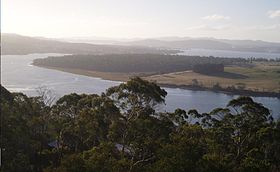Tamar River, Tasmania
| Tamar River (kanamaluka) | |
| Estuary | |
|
The Tamar from Brady's lookout, near Exeter
|
|
| Name origin: River Tamar | |
| Country | Australia |
|---|---|
| Regions | Tasmania, Northern Tasmania |
| Tributaries | |
| - left | Supply River |
| City | Launceston |
| Source confluence | South and North Esk Rivers |
| - location | Launceston |
| - coordinates | 41°26′4″S 147°7′38″E / 41.43444°S 147.12722°E |
| Mouth | Port Dalrymple, Bass Strait |
| - location | Low Head |
| - elevation | 0 m (0 ft) |
| - coordinates | 41°3′19″S 146°46′28″E / 41.05528°S 146.77444°ECoordinates: 41°3′19″S 146°46′28″E / 41.05528°S 146.77444°E |
| Length | 70 km (43 mi) |
| State reserve | Tamar River Conservation Area |
The Tamar River (Indigenous palawa kani name: kanamaluka) is a 70-kilometre (43-mile) estuary located in northern Tasmania, Australia. Despite being called a river, the waterway is a saline and tidal estuary over its entire length.
Formed by the confluence of the North Esk and South Esk rivers at Launceston, the Tamar flows generally north towards its mouth at Low Head, north of the settlement George Town and into the Bass Strait via Port Dalrymple. The Tamar has several minor tributaries including the Supply River.
Low Head Lighthouse is located at the tip of a peninsula, on the east side of the mouth of the Tamar River. The only full crossing of the Tamar is the Batman Bridge in the relatively remote area of Sidmouth, around halfway up the river.
Although the Port of Launceston is now used very little in comparison to the past and the SeaCat Tasmania ferry no longer docks at George Town, the Tamar still is used for shipping, with light and heavy industries at George Town including aluminium smelters as well as commercial boat cruises.
The Tamar River was named after the River Tamar in South West England by Colonel William Paterson in December 1804.
...
Wikipedia


